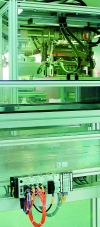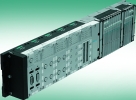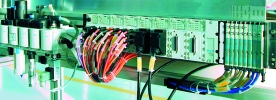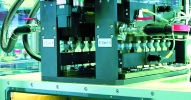
Through its contribution of industry-specific pneumatic components, Festo is providing strong support for the production process of Osram xenon lamps in Berlin.
A Scheugenpflug inline vacuum casting machine is used to achieve bubble-free filling of the Osram lamp bases with casting compound. With Scheugenpflug machines, pneumatics is an important part of the system design. Compressed air is used for both control and handling functions, particularly in the preparation of the casting compound, for the dosing system, and in handling and conveyor systems. Loading and unloading robots equipped with the usual types of interfaces are typical examples of the equipment installed in the various assembly stations within the machine. The combination of a CPX modular electrical terminal and an MPA Modular Performance valve terminal from Festo acts as a bridge between the electrical and pneumatic systems and links the various control chains together.

All the I/O modules, including the various valve functions, are linked quickly and easily to the machine controller via Profibus DP. The additional free inputs and outputs of the CPX/MPA combination are used to trigger the surrounding peripheral components, for example a robot handling device. A conventional valve-terminal solution would have long since reached its limits, due to the large number of actuators and sensors involved.

A number of different work pieces can be produced in the course of a day. A robot at the infeed/outfeed station places the cast work pieces into transport pallets one row at a time. The pallets then travel via a test station and a preheating oven into the inline vacuum casting station. After the casting chamber, the finished work pieces pass through a hardening oven, followed by a cooling zone. They then return to the infeed/outfeed station, where they are placed back on a conveyor belt by a handling device.

The production sequence for the casting of the lamp bases consists of numerous individual operations. As is usual in assembly operations, the longest movements are associated with the handling of the work piece carriers. Before they are cast, the lamp bases must be placed at individual locations on the pallets and their condition and orientation must be checked. Shortly before the vacuum chamber, the work piece carriers pass through a preheating oven before the locked doors of the chamber open. Inside the chamber is a pallet positioner and conveyor which allows stepless movements in three directions. The lamp bases are then filled with casting compound by the multiple dosing head on a linear table. During this operation, the work piece carrier is locked onto an NC- controlled mini slide.

An integrated work piece detection system identifies any empty spaces on the work piece carrier and omits these from the casting operation. Once the work pieces have been filled with compound, the carrier transports them to the after-hardening process. The complete lamp bases are then fed to the transfer station and transported onwards for further processing.
For more information contact Joanne Dix, Festo, 011 971 5560, [email protected], www.festo.com
| Email: | [email protected] |
| www: | www.festo.co.za |
| Articles: | More information and articles about Festo South Africa |

© Technews Publishing (Pty) Ltd | All Rights Reserved